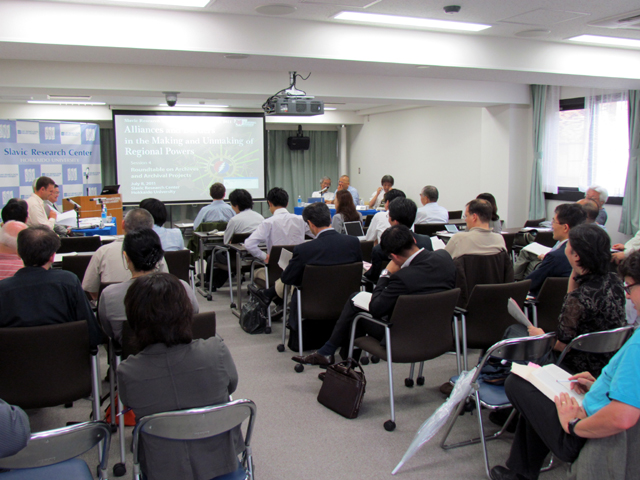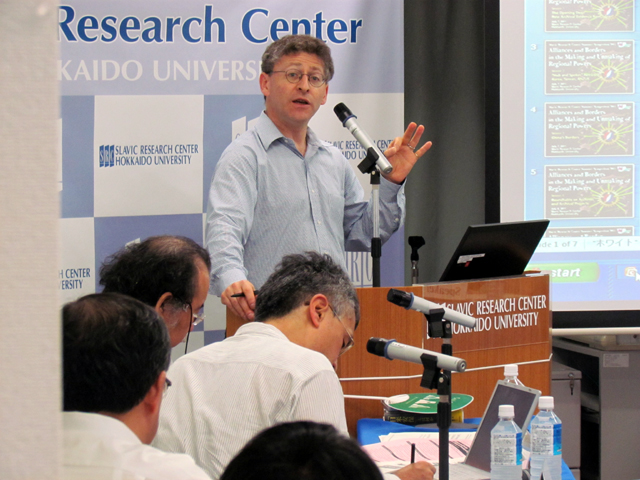|
The Fifth International Symposium of
Comparative Research on Major Regional Powers in Eurasia
“Alliances and Borders in the Making and Unmaking of Regional Powers”
Report
by David Wolff (Slavic Research Center)
On July 7-8, 2011, the Slavic Research Center hosted a Summer Symposium
on “Alliances and Borders in the Making and Unmaking of Regional
Powers.” With support from the New Academic Knowledge Project on
“Comparative Research on Major Regional Powers in Eurasia” (Tabata
Shinichiro, Head), the Global Center of Excellence on “Reshaping
Japan’s Border Studies” (Iwashita Akihiro, Head) and A-level JSPS
Research Project on “The Cold War in Northeast Asia” (David Wolff,
Head), the Symposium brought together an international group of experts
to commemorate both the 60th anniversary of the US-Japan Treaty and
Alliance and the 20th anniversary of the end of the Soviet Union. One
event was the most significant step in defining Cold War alliances and
borders in Asia. The other was the defining event in reshaping
contemporary Europe.
The vision
of two empires battling over Europe and Asia has been enshrined in the
canon of the Cold War, but reality was often more complex than this
simple geometry. The very process of concluding an agreement could
contain within it the seeds of future disagreements. The secret clauses
of the Sino-Soviet agreement of 1950 made Mao bitter forever against
Stalin and other “new Tsars.” The US-Japan alliance bargain of the
following year with its implicit trade of bases for security umbrella,
together with the relevant clauses of the “MacArthur Constitution,”
made it possible for the Japanese to avoid the costs of rearmament,
although the US later complained. In the Sino-Soviet and US-Japan
cases, the economic promises that accompanied security treaties also
led to long-term recriminations. In hindsight, it seems apparent that
intended asymmetries, the heart of the deal, could over time lead to
perceived inequalities and alliance demise.
Just as important, alliances were
almost always against an enemy, creating a hidden triangle, also at the
heart of the deal. Thus, any change by either ally, even the most
desirable lessening of tension with the enemy, could lead to fears of
betrayal, the risk of a “separate peace.” It is in these terms that
American reaction to Japanese parliamentary visits to China in the
1950s and the American opening to China in the 1970s must be analyzed.
Borders are often just as
baffling. With Cold War putting the brakes on all out war, border
clashes, along with partisan warfare, clandestine operations, “public
diplomacy” and various other forms of “lesser war,” truly politics by
other means in Clausewitz’s classic formulation, took the field. The
Sino-Soviet border, the world’s longest, served briefly for friendship,
but more enduringly as a great divide. Border conflicts, relatively
minor bloodlettings, often reveal the hidden triangles underlying
fragile alliances. Thus, the 1959 and 1962 Sino-Indian clashes soon
became a factor in the death of the Sino-Soviet alliance and the
weakening of Nehru’s cherished vision of non-alignment, the
“anti-alliance” path. The 1969 Sino-Soviet border clashes along the
Ussuri and in Xinjiang were China’s clear signal to the US that one
alliance was over and another could begin.
From Stalin to Deng, from Nixon
to Nakasone, the conundrums of border and alliance were leveraged by
the statesmen of our age in attempts to build or thwart regional
hegemony. As often as not, strategies and plans backfired, but the
basic configurations still hold, glued together by communal interests
from the past and shared fears of the future. It is the very stuff of
which regional powers are made. All this, and more, was presented and
discussed during two exciting days in Sapporo. A forthcoming issue of
the GCOE’s Eurasian Border Review will feature these papers.
Link:
Symposium Program


[index]
|

